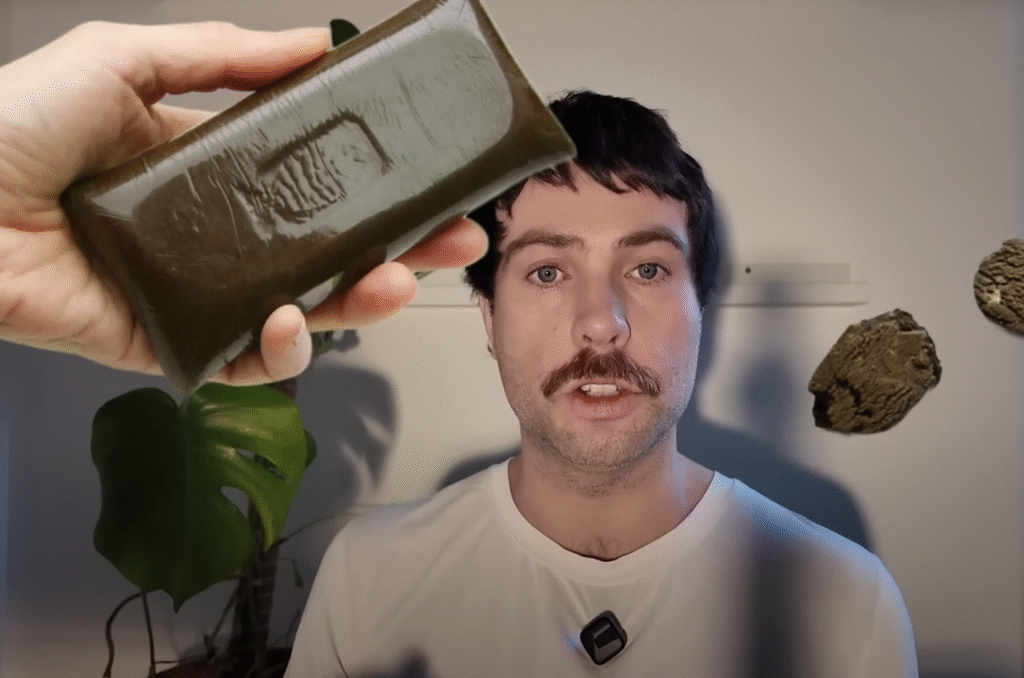Cannabis has always been tied up with culture, community, and controversy. In a recent video, Simon Doherty digs deep into the history of one of Britain’s most infamous cannabis products: soap bar hash.
This hash was one of the lowest-quality cannabis resins the UK ever saw. Cheap, adulterated, and often outright dangerous, it held sway over the market for years – particularly in the 1980s, 90s, and early 2000s.
Based on Doherty’s interview with researchers and users, this article revisits what made soap bar so notorious.
As one person in the documentary put it: “Have you ever heard of soap bar? Oh, wouldn’t touch it with a barge pole.”
What was soap bar?
Hashish, or hash, is traditionally made by pressing the resin glands of female cannabis plants into a block. Good hash is pliable, aromatic, and bubbles under a flame. Soap bar was the opposite: rock hard, bitter, and often useless for anything but a doorstop.
It was sold in 250g “nine bars” shaped like soap, hence the name. Cheap though it was – in the early 2000s, a nine bar cost around £250 in the north of England, and a quarter ounce went for about £10 – what you paid for was barely recognisable as cannabis.
What was in it?
Reports and studies show only about 5–10% of soap bar was actually cannabis. The rest was a messy mix of fillers and contaminants, including:
- Straw, leaves, stems, and twigs
- Paraffin wax, beeswax, and coffee for colour and texture
- Boot polish, turpentine, and even engine oil
- Soil, plastic, dust, and other nasty stuff
Nick Cranson, editor of Redeye magazine, told The Independent in 2005:
“Moroccan-made soap bar is made from about 10% ground-up vegetable matter … and then around 90% adulterant. It’s bound with beeswax, Nescafé coffee is added for colour, and it’s given a lick of turpentine for a shine. Basically, it’s crap. It’s bad for you.”
Smoking the sludge
Soap bar’s effect was weak and harsh. Users reported headaches, bitter taste, and a skanky quality. To feel anything, many resorted to extreme intake methods:
- Buckets, where smoke would be trapped and then inhaled in one go
- Hot knives, heating two knives and pressing the hash between them, inhaling the resulting fumes
It also led to “hot rocks” – bits of hash falling from joints that burned holes in clothes, a telling mark of soap bar’s combustibility.

The research
French researcher Pierre-Arnaud Chouvy studied the resin trade and found that soap bar was already adulterated before it left Morocco, only to be bulked up further in transit through Spain or the Netherlands.
Before 2012, the average THC in soap bar was around 8%. Today’s resins frequently over 20% or more. A British impurities survey found seized soap bar between 1999 and 2001 contained up to 80% non-cannabis material.
The end of soap bar
By the mid-2000s, soap bar was fading fast. Changes in law (downgrading cannabis to a Class C in 2004) encouraged home growing in the UK. Fresher, stronger weed became more plentiful, and resin lost ground. When cannabis was reclassified back to Class B in 2009, the homegrown market was already thriving.
Soap bar didn’t vanish overnight. But today, it’s rarely seen. And few mourn its disappearance.
As one researcher summed up:
“We used to call hash merde [meaning ‘shit’] in French. We still do. Not sure if it was the colour or the quality, but it was fitting.”
Final thought
Soap bar was born from prohibition, low supply, and unscrupulous profit margins. It thrived because for many there was no better alternative. But its decline shows how markets shift and how quality, regulation, and transparency can reduce harms from similar fads.
For anyone who ever smoked soap bar in the 90s, the smell of burning plastic or the sight of hot rocks on tracksuit bottoms won’t soon be forgotten.
Watch the full video here.
Sign up to our free newsletter below, and we’ll send you a weekly update on all things weed in the UK – as well as our guide to accessing medical cannabis in the UK.




